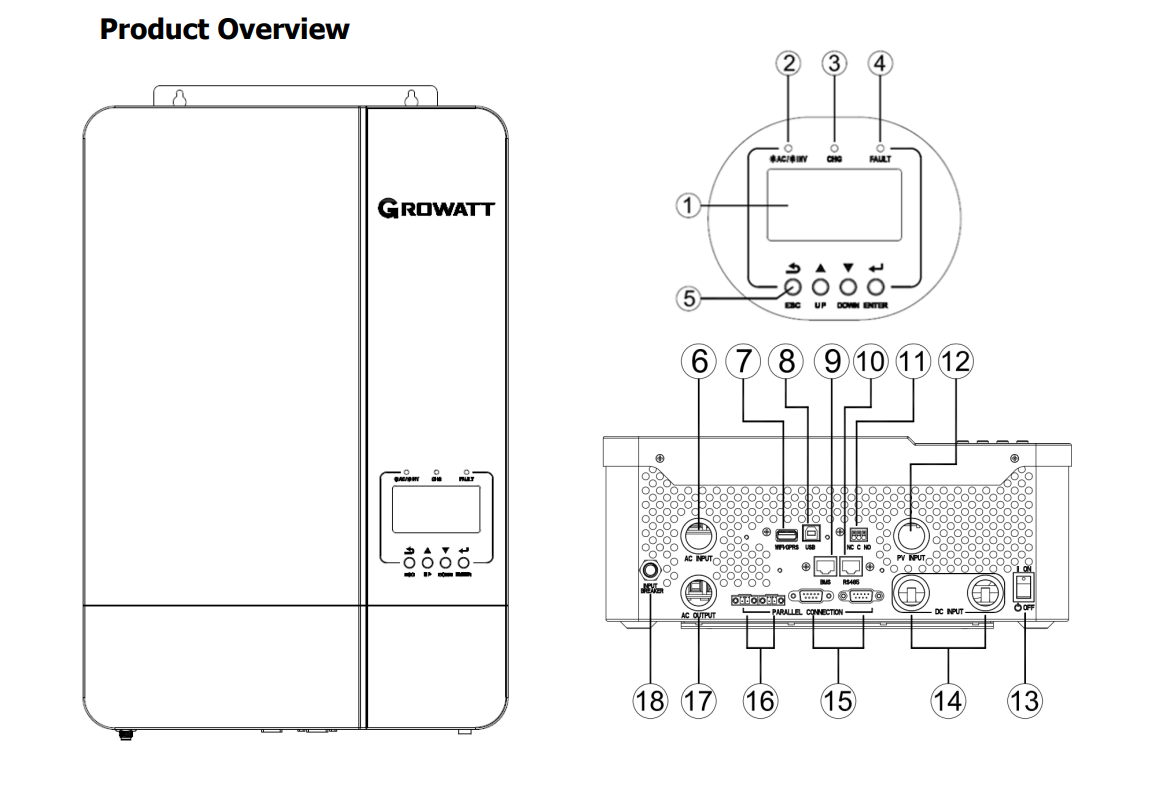OFF Grid Off Grid Hybrid MPPT Solar Inverter SPF 5000 ES Solar Inverter Single Phase Hybrid Inverter
- Input Voltage230 VAC
- Output Voltage230VAC ± 5%
- Output Current80A
- Output Frequency50Hz/60Hz
- Output TypeSingle, Pure sine
- Size330*485*135mm
- TypeDC/AC Inverters
- Inverter Efficiency98%
- CertificateCE Rohs, CE ROHS
- Weight12KG
Integrated MPPT charge controller.
Equalization charging function.
Maximum PV input voltage up to 450VDC.
Configurable grid or solar input priorty.
Optionali WIFI/GPRS remote monitoring.
Support parallel operation for capacity expansion up to 30kW.
PV and Grid power the load jointly if PV energy unsufficient.
Flexibly schedule the Inverter charging and discharging time.
- Rated power 3.5KW to 5KW, power factor 1
- MPPT ranges 120V~430V, 450Voc
- High frequency inverter with small size and light weight
- Pure sine wave AC output
- Solar and utility grid can power loads at the same time
- With CAN/RS485 for BMS communication
- With the ability to work without battery
- Parallel operation up to 6 unit (only with battery connected)
- WIFI/ GPRS remote monitoring (optional)
| Datasheet | SPF 3500ES | SPF 5000ES | ||
| Battery Voltage | 48VDC | |||
| Battery Type | Lithium/Lead-acid | |||
| INVERTER OUTPUT | ||||
| Riated Power | 3500VA/ 3500W | 5000VA 5000W | ||
| Parallel Capability | Yes, 6 units maximum | |||
| AC Voltage Regulation (Battery Mode) | 230VAC士5% @ 50/60Hz | |||
| Surge Power | 7000VA | 10000VA | ||
| Efficiency (Peak) | 93% | |||
| Waveform | Pure sine wave | |||
| Transfer Time | 10ms typical 20ms Max | |||
| SOLAR CHARGER | ||||
| Maximum PV Array Power | 4500W | 6000W | ||
| MPPT Range @ Operating Voltage | 120VDC一430VDC | |||
|
Number of independent MPP Trackers
/Strings per MPP Tracker
|
1/1 | |||
| Maimum PV Array Open Circuit Voltage | 450MDC | |||
| Maximum Solar Charge Current | 80A | 100A | ||
| AC CHARGER | ||||
| Charge Curent | 60A | 80A | ||
| AC input Voltage | 230 VAC | |||
| Selectable Voltage Range | 170-280 VAC (For Personal Computers]:; 90-280 VAC (For Home Appliances) | |||
| Frequency Range | 50Hz/60Hz (Auto sensing) | |||
| PHYSICAL | ||||
| Protection Degree | IP20 | |||
| Dimension (W/H/D) | 330/485/135 | 330/485/135mm | ||
| Net Weight | 11.5KGS | 12KGS | ||
| OPERATING ENVIRONMENT | ||||
| Humidity | 5% to 95% Relative Humidiy(Non-condensing) | |||
| Altitude | <2000m | |||
| Operating Temperature | 0℃- 55℃ | |||
| Storage Temperature | -15℃~60℃ | |||


Manufacture: Our factory is 12,000 sq. ft. with more than 150 employees that produces 1000+ battery packs a day. We take full control over cost, quality and delivery of our products.
Reliability: The company is ISO9001, ISO14001:2015, BSCI certified, and our products are certified by standards like CE, UL, FCC, RoHS, MSDS, UN38.3, etc.
Quality: From raw materials to finished products, every link is under ISO9001:2015 Quality Management System. Highly automated production lines ensure the consistency and stability of product quality.
R&D: With a R&D team of over 10 senior engineers and specialized laboratory, we are capable of customizing any battery packs that meet your requirements.
Delivery: We have our own associated spare parts factory which can help for fast delivery.
Warranty: Thoughtful after-sales service, 5 years warranty and lifelong technique support.
Below are the answers to the questions that you may like to ask for
Can I charge the battery from the mains?
Short answer is yes but it will require a hybrid inverter. This would mean you could charge the battery at a cheap night rate from the grid as well as charging the battery from the solar PV.
Can I have an Uninterrupted supply (UPS) if there is a powercut?
Yes but would need to be wired to a dedicated circuit within the house, for example the upstairs sockets and downstairs lighting, this would then provide you with emergency power in the event of you losing the mains.
What’s the best location for batteries?
They work best in a room that doesn’t get too hot – Ideally they would go in a garage but they can go in a loft or any other room but the warmer they get the less efficient they become. The operating temperature ranges from -10 to 50 degrees but will see efficiency drops below 0 and above 40 degrees
Are Batteries safe?
Batteries are no more unsafe than any other electrical installation, as with anything there are risks but these are very small and should be a great consideration.
Can I add more batteries at a later date?
Yes, YuYang Energy batteries can accept a further 14 battery packs taking, the total capacity can reach to 76.8kWh with 15 packs of 51.2V 100Ah battery.
How long do they last?
This is actually determined by the number of cycles the battery goes through, this means a full charge and discharge. On average a battery will last around 10 years and all batteries have at least a 5 year warranty and most can be extended to 10-years.
What’s the difference between Capacity and useable capacity?
Most batteries will have a capacity and a useable capacity – this can be confusing but in basic terms batteries should never been fully discharged and as such the useable capacity takes this into account.
